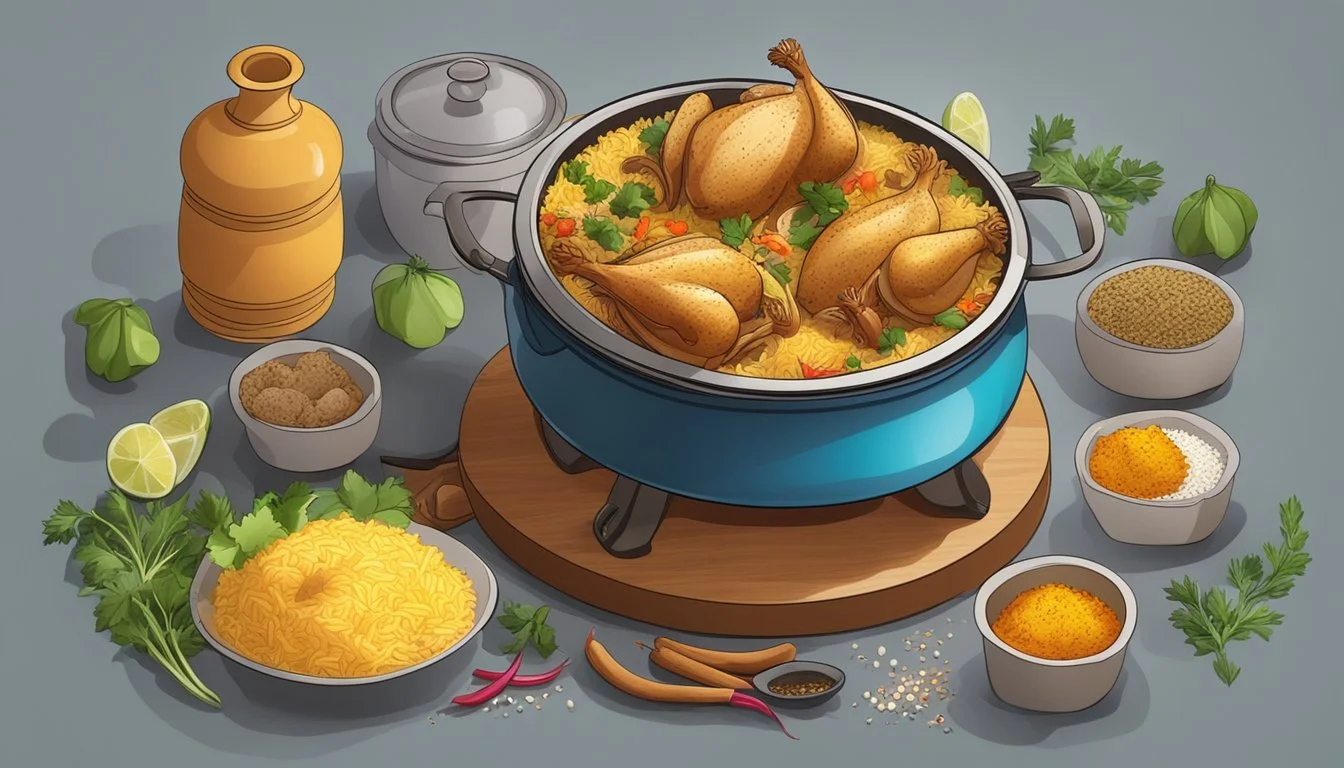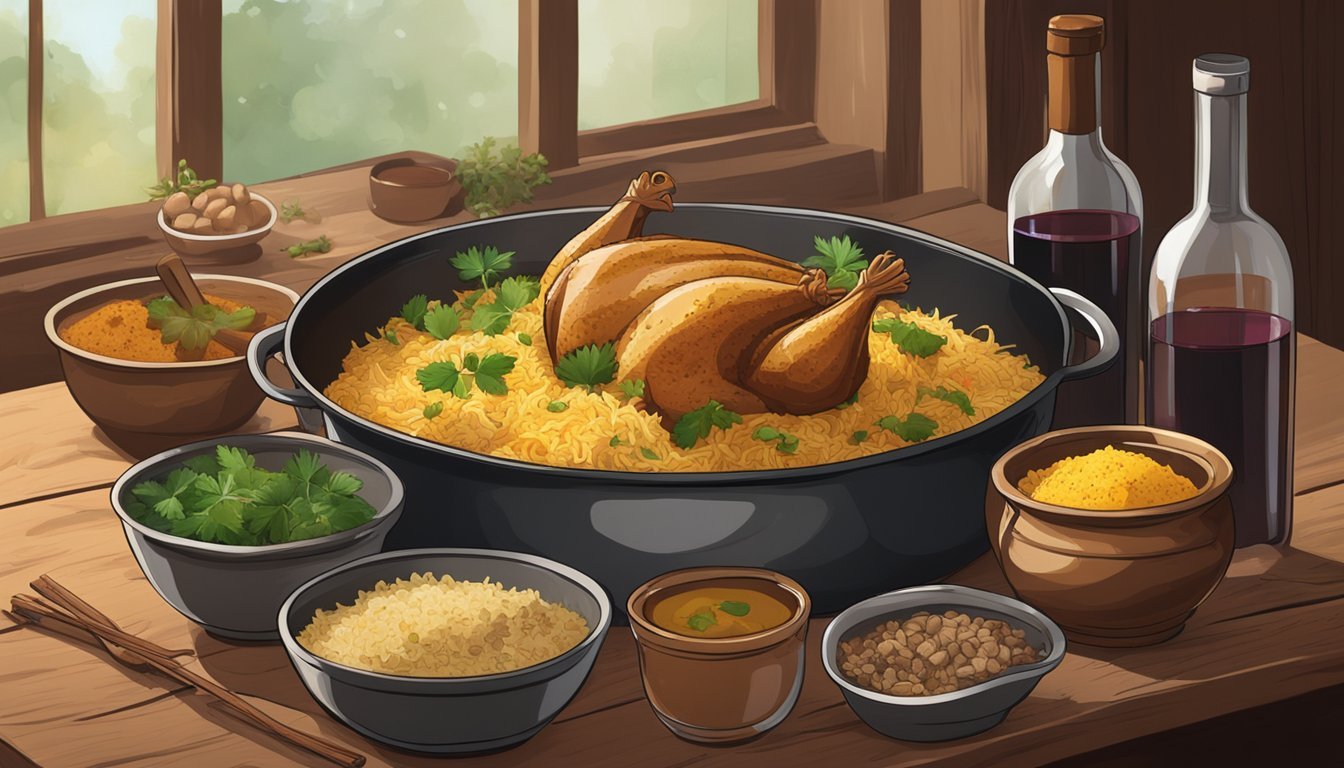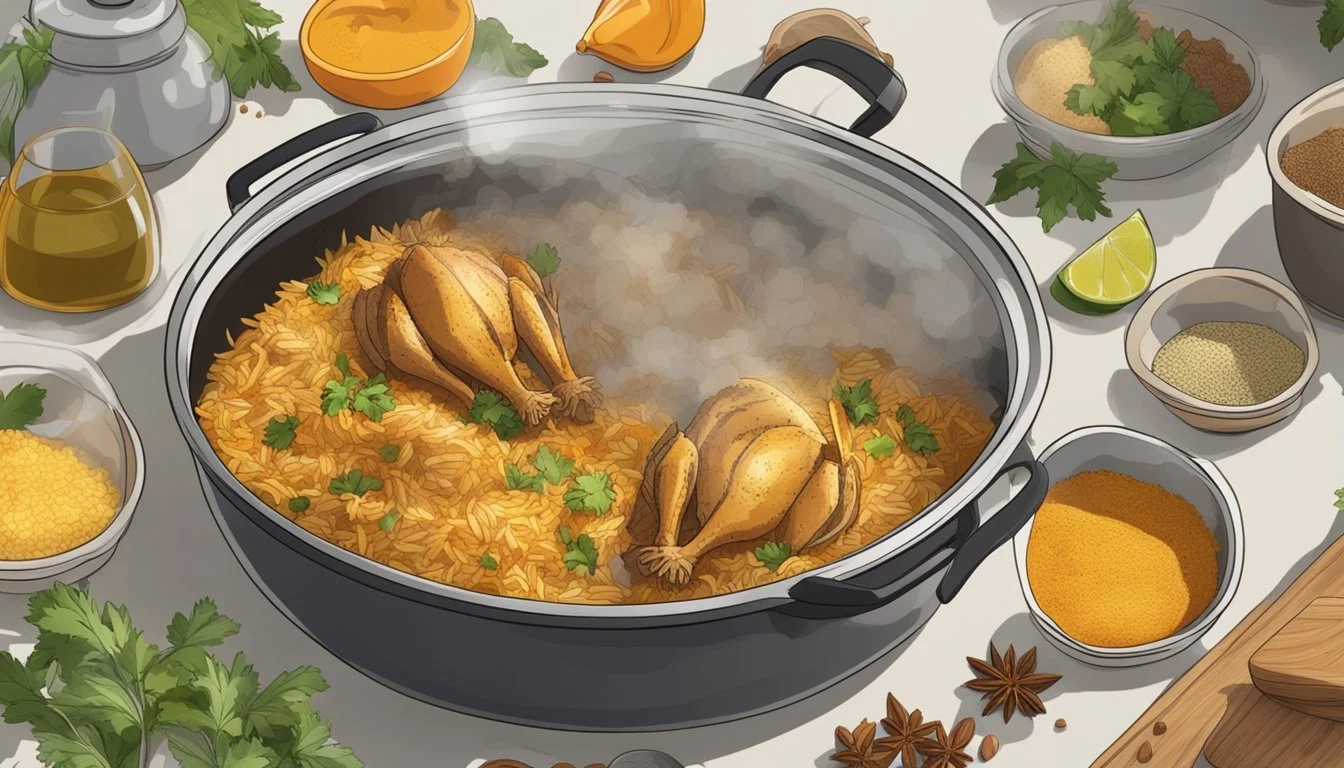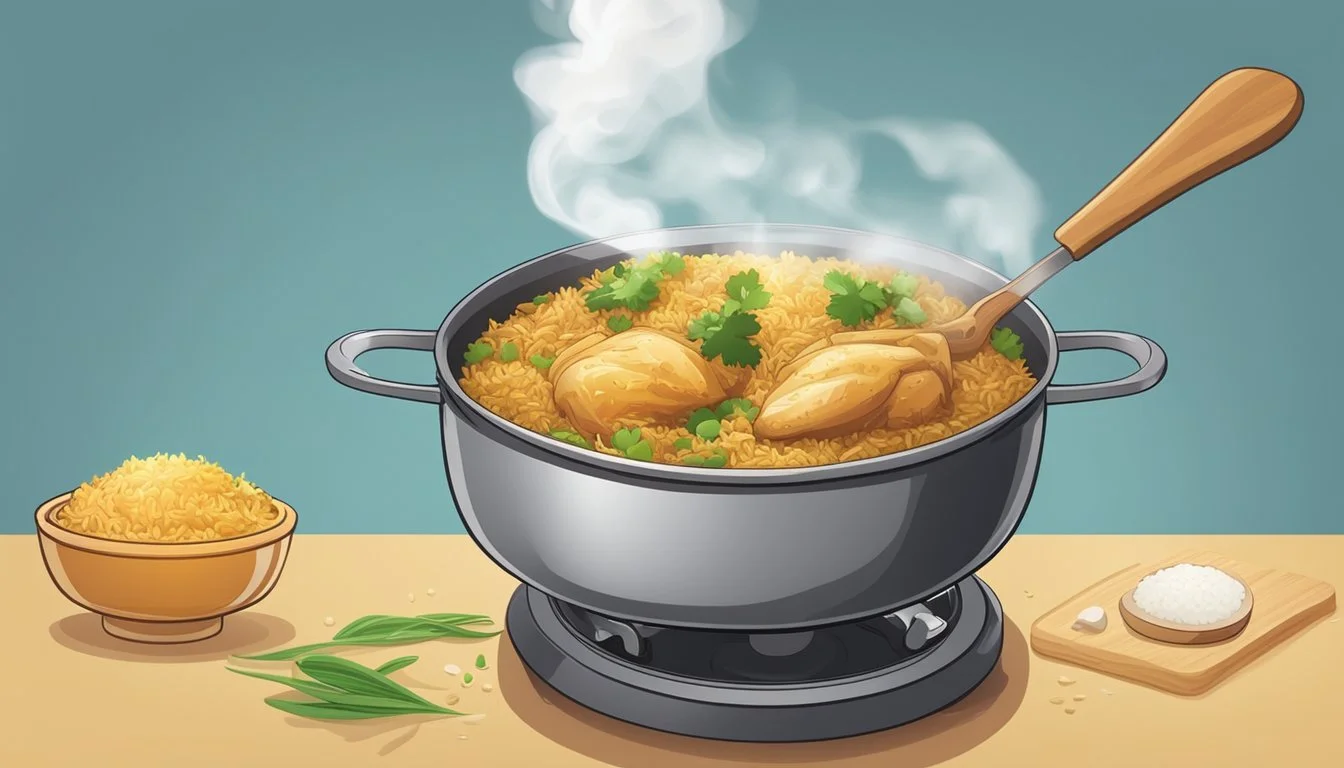How Long Does Chicken Biryani Last?
Proper Storage Tips
Chicken Biryani, a cherished Indian dish, combines fragrant rice, tender chicken, and a rich blend of spices. It's a favorite in households around the world for its aromatic and flavorful profile. As delicious as it is, knowing how long it can safely be kept is essential for enjoying it to the fullest while avoiding foodborne illness.
Stored in an airtight container, chicken biryani can last in the refrigerator for two to four days. This timeframe ensures that the flavors remain intact and the dish stays safe to eat. Leaving biryani out at room temperature should never exceed two hours, especially in hot and humid climates, to prevent the growth of harmful microorganisms.
Being mindful of these storage guidelines helps maintain the dish's integrity and safety. Whether it's a homemade recipe brimming with spices and marinated chicken or a delightful takeout, adhering to proper storage practices ensures every bite of chicken biryani is both enjoyable and safe to consume.
Understanding Biryani
Biryani is a beloved dish known for its rich flavors and cultural significance. This section covers its historical roots and essential preparation methods.
History and Significance
Biryani's origins can be traced back to Persian and Mughal influences in India. Introduced during the Mughal Empire, it was initially prepared in royal kitchens. Over time, various regional adaptations emerged. Each region in India, from Hyderabad to Kolkata, has its unique version with distinct spices and ingredients. Biryani is often associated with celebratory occasions and festivals, signifying its importance in Indian culture.
Preparation Overview
Preparing biryani involves several key steps, starting with marinating the chicken in a mixture of yogurt, garlic, ginger, and a blend of spices such as garam masala and turmeric. This marination enhances the flavor and tenderness of the chicken. Basmati rice is typically used, known for its aromatic properties. The rice is partially cooked and layered with the marinated chicken. Saffron, soaked in milk, is often sprinkled over the top, adding a distinctive aroma and color. The dish is then slow-cooked, allowing the flavors to meld together, resulting in a rich and fragrant meal.
Biryani Recipe Breakdown
Biryani is a layered rice and protein dish filled with complex flavors and textures. Key elements include the selection of rice and protein, the marinade composition, and the layering technique.
Selection of Rice and Protein
The choice of rice and protein is fundamental. Basmati Rice is preferred for its long grains and aromatic nature. Protein options often include Chicken Thighs, known for their juicy and tender qualities. High-quality chicken thighs ensure even cooking and absorb flavors well, making them ideal for biryani. Rinse the rice thoroughly to remove excess starch, ensuring the grains remain separate and fluffy during cooking.
Marinade Composition
The marinade for Chicken Biryani typically includes Greek Yogurt, lemon juice, and a blend of spices such as cumin, coriander, and turmeric. Greek Yogurt helps tenderize the chicken, making it juicy and flavorful. Adding lemon juice enhances the marinade's effectiveness in breaking down the protein, leading to a tender bite. Allowing the chicken to marinate for at least 30 minutes, but optimally up to 4 hours, ensures the spices penetrate deeply.
Layering Technique
The layering technique is crucial. Begin by partially cooking the Basmati Rice and then layer it alternately with the marinated chicken in a heavy-bottomed pot or Dutch oven. Each layer of chicken and rice should be interspersed with fried onions, cilantro, and mint. This layering captures the rich flavors and aromas, allowing them to meld during the slow cooking process. Seal the pot tightly and cook on low heat. This method ensures that the steam gently cooks the rice and chicken, creating a meld of tender grains and succulent protein.
Storage and Shelf Life
Chicken biryani, when stored correctly, can retain its flavor and safety for days in the fridge or months in the freezer. Proper storage conditions and recognizing spoilage signs are crucial to enjoying this popular dish safely.
Optimal Storage Conditions
Proper storage is key to maintaining the quality and safety of chicken biryani. Store it in an airtight container to prevent contamination and preserve moisture. An airtight container also helps in reducing the risk of bacterial growth. If the biryani is still hot, allow it to cool down to room temperature before sealing and refrigerating it. Never leave biryani out for more than two hours as it increases the risk of foodborne illnesses.
Refrigeration and Freezing
Refrigeration: Chicken biryani can be stored in the refrigerator for up to four days. Set your refrigerator at or below 40°F (4°C). Always use airtight containers to minimize moisture loss and prevent contamination.
Freezing: To extend the shelf life, freeze the biryani. It can last up to two months in the freezer. Portion the biryani into single-serving containers for easy thawing and reheating. Use heavy-duty freezer bags or airtight containers to avoid freezer burn and maintain quality.
Reheating: When reheating biryani, ensure it reaches an internal temperature of 165°F (74°C) to kill any potential bacteria. Add a splash of water during reheating to keep the rice moist.
Recognizing Spoilage
Identifying spoiled biryani is crucial for food safety. Visual signs include discoloration and the presence of mold. If the rice grains appear overly dry or have an unusual texture, it's likely spoiled.
Smell: A sour or off smell is a clear indicator of spoilage. Biryani typically has aromatic spices, so any deviation to a pungent or unpleasant odor is a red flag.
Texture and Taste: If the biryani feels slimy or has a strange taste, discard it immediately. Fresh chicken biryani should have a firm texture and rich flavor. When in doubt, it's safer to throw it out rather than risk food poisoning.
Nutrition and Health Aspects
Chicken biryani provides a rich balance of macronutrients and essential micronutrients which contribute to its nutritional profile. Understanding these components can help in assessing its place in a balanced diet.
Caloric and Macronutrient Content
Chicken biryani contains a moderate amount of calories. For instance, 100 grams of chicken biryani typically provides around 180-200 calories. These calories are derived from a mix of carbohydrates, proteins, and fats:
Carbohydrates: Approximately 25-30 grams per 100 grams, these come mostly from rice.
Protein: Contains about 10-12 grams per 100 grams, mainly from chicken.
Fat: Roughly 6-8 grams per 100 grams, including both cooking oil and the fat in chicken.
It contains minimal sugar but has a presence of saturated fat due to the ghee or oil used. For those monitoring cholesterol, biryani can contain noticeable amounts, depending on the preparation method and use of ingredients.
Micronutrients and Benefits
Chicken biryani is also a source of valuable micronutrients:
Sodium: Levels can be high due to salt and spices, which might be a concern for those with hypertension.
Potassium: Provides beneficial potassium aiding in electrolyte balance and muscle function.
Vitamins:
Vitamin A: Important for vision and immune function.
Vitamin C: While not a significant source, it adds to the overall intake through herbs and vegetables.
Minerals:
Calcium: Aids in bone health, though present in minimal amounts.
Iron: Biryani can offer iron, essential for red blood cell production.
Incorporating cilantro and mint as garnishes can enhance its nutritional value, providing additional vitamins and antioxidants.
Serving and Pairing Ideas
Chicken biryani can be wonderfully complemented by both traditional accompaniments and modern fusion pairings. These pairings not only enhance flavors but also provide a balanced dining experience.
Traditional Accompaniments
Raita: This cooling yogurt-based side dish balances the rich spices of chicken biryani. A basic raita often includes cucumbers, mint leaves, and a hint of cumin.
Naan: Soft, buttery naan bread makes for an excellent pairing. It can be used to scoop up the biryani and can be enhanced with a sprinkle of garlic or herbs.
Fried Onions: Often used as a garnish, fried onions add a crispy texture and a slight sweetness to each bite.
Mint Leaves: Fresh mint leaves provide a burst of freshness. They can be sprinkled over the top or mixed into the biryani.
Modern Fusion Pairings
Butter Chicken: Pairing chicken biryani with butter chicken can amplify the dining experience. The creamy, tomato-based gravy complements the spicy biryani.
Sautéed Potatoes: Lightly seasoned and sautéed potatoes can add a comforting, earthy flavor.
Tomato Chutney: A tangy tomato chutney can bring a spicy and sweet balance to the meal. It pairs well with the biryani's aromatic spices.
Onion Salad: A simple salad with sliced onions, lemon juice, and a pinch of salt can enhance the overall flavor profile.
By incorporating these pairings, the dining experience becomes more varied and enjoyable.
Troubleshooting Common Issues
When storing chicken biryani, various issues can arise that may affect its texture, flavor, and appearance. This section addresses these issues and provides practical solutions to ensure your biryani remains delicious and appealing.
Texture Problems
Sticky Rice: To avoid sticky rice after reheating, distribute the biryani evenly in an oven-safe dish and gently break up any clumps. Adding a small amount of water or chicken stock, about a tablespoon per cup of rice, can help maintain moisture without causing stickiness.
Dry Biryani: Cover the dish with foil or a lid when reheating. This traps steam and prevents the rice from drying out. Using ingredients like saffron or bay leaves can also enhance the texture by adding subtle moisture and fragrance.
Mushy Texture: Ensure the biryani is not overcooked during the initial preparation. When reheating, avoid high temperatures or prolonged heating times. Stirring gently can help maintain the grainy texture of the rice.
Flavor Enhancements
Dull Flavor: Adding fresh spices like red chili powder or a cinnamon stick can revitalize the flavors of reheated biryani. Mixing in a small amount of fresh ginger and garlic paste can also enhance the taste.
Missing Fragrance: Incorporating aromatic spices such as saffron, bay leaves, and whole spices like cinnamon stick during the reheating process can bring back the characteristic biryani aroma. Adding a few fresh chopped tomatoes can boost the overall flavor profile.
Unbalanced Spice Levels: If the spices seem too mild after storage, consider adding a bit more of your favorite seasonings. A pinch of red chili powder or garam masala can bring the spices back to life. Be careful not to add too much, as reheated flavors can intensify quickly.
Color and Appearance Adjustments
Faded Colors: Reheating can sometimes cause the vibrant colors of biryani to fade. To restore its visual appeal, consider adding a small pinch of saffron soaked in warm water. This will not only enhance the color but also add a fragrant touch.
Uneven Coloring: Stir the biryani gently and mix well to ensure even distribution of colors. Adding a few drops of tomato puree can also help in achieving a richer, more consistent appearance.
Pale Look: To remedy a pale appearance, you can sprinkle a small amount of red chili powder over the top before serving. This adds a slight color boost and an extra kick of flavor.
Reheating and Leftover Tricks
Chicken biryani can maintain its texture and flavor if reheated correctly. Additionally, leftover biryani can be creatively used in various dishes, ensuring nothing goes to waste.
Methods for Reheating
Oven: Preheat to 300°F (150°C). Place biryani in an oven-safe dish, spreading it evenly. Add a tablespoon of water or stock per cup of rice to keep it moist. Cover the dish with foil or a lid, then heat for about 15 minutes.
Microwave: Place biryani in a microwave-safe container. Cover and heat on medium power for 2-3 minutes per serving, stirring halfway to ensure even heating.
Stovetop: Use a non-stick skillet or Dutch oven. Add the biryani and a splash of water. Cover with a tight-fitting lid and heat on low for 5-6 minutes, stirring occasionally.
Creative Uses for Leftovers
Biryani Patties: Combine leftover biryani with a beaten egg. Form into patties and pan-fry until golden brown. Serve with a side of yogurt or chutney.
Stuffed Peppers: Hollow out bell peppers and fill them with biryani. Top with cheese and bake at 350°F (175°C) for 20 minutes.
Biryani Fried Rice: Sauté leftover biryani in a hot skillet with a bit of oil. Add scrambled eggs, peas, and soy sauce for a quick fried rice dish.
Biryani Burritos: Use leftover biryani as a filling for burritos. Add fresh vegetables, cheese, and a dollop of yogurt for a fusion twist.
Variations and Customizations
Chicken Biryani offers a multitude of variations and customizations based on regional influences and dietary needs. These variations leverage different spices, vegetables, and preparation methods, significantly altering the dish's flavor profile and accommodating diverse dietary preferences.
Regional Variations
Hyderabadi Biryani uses a layered approach with marinated chicken, rice, and whole spices like cardamom and cloves. It often includes fried onions for added sweetness.
Kolkata Biryani is milder and incorporates potatoes and boiled eggs. The dish is less spicy and relies more on the aromatic essence of garam masala.
Malabar Biryani from Kerala features a distinct flavor due to the use of coconut milk and curry leaves. This variation provides a smoother, richer texture.
Lucknowi or Awadhi Biryani is fragrance-rich and uses a unique marination process with yogurt and specific spice blends that create a subtler taste.
Dietary Adaptations
Vegetarian Biryani substitutes chicken with a mix of vegetables like carrots, peas, and potatoes. Extra spices and biryani masala keep the flavors robust.
Vegan Biryani skips any dairy or meat products, using tofu or tempeh as protein sources. Coconut milk can replace yogurt for marination.
Gluten-Free Biryani ensures that ingredients are free from wheat-based additives. Using naturally gluten-free spices and fresh ingredients helps maintain the dish's integrity.
Low-Carb Biryani uses cauliflower rice in place of traditional basmati rice. This adaptation keeps the biryani flavorful while reducing carbohydrate intake.
Keto-Friendly Biryani** bypasses regular rice altogether, opting for alternatives that fit within a low-carb, high-fat diet. Mixing chicken with high-fat vegetables and spices meets dietary restrictions without losing taste.
Cooking Techniques and Equipment
Cooking chicken biryani effectively involves using both traditional methods and modern kitchen tools to achieve the ideal flavor and texture. Key elements include the proper use of cooking vessels and the choice of oils and cooking times.
Traditional Methods
Traditional cooking methods for chicken biryani typically involve heavy-bottomed pots such as a Dutch Oven or a large skillet. These vessels ensure even heat distribution, preventing the biryani from burning.
Dutch Oven: Often used for its ability to retain heat and cook food slowly.
Large Skillet: Suitable for sautéing onions, spices, and other ingredients.
Ghee or vegetable oil is commonly used for sautéing onions until they are golden brown. This step is crucial for adding rich depth to the biryani. Layers of marinated chicken and partially cooked rice are then added. Cooking time can vary, but allowing the dish to rest and steam in its own juices is essential for enhancing flavors.
Modern Kitchen Tools
Modern kitchen tools can simplify the biryani-making process without compromising on taste.
Instant Pot: This versatile tool can sauté, pressure cook, and slow cook. Its sauté function is ideal for browning onions and spices, while the pressure cook setting speeds up the overall process.
Electric Rice Cooker: Perfect for making the rice component, ensuring fluffy and evenly cooked grains.
Chicken stock can be used instead of water to add more depth to the dish. The convenience of these tools reduces the cook time significantly while delivering authentic results. Integrating both traditional and modern methods ensures a balanced and flavorful chicken biryani that stands the test of time.
Planning and Time Management
Effective planning and time management are crucial when preparing Chicken Biryani. Organizing the preparation and cooking steps can ensure that the dish is flavorful and ready to serve on time.
Preparation Timeline
Prepping for Chicken Biryani involves several stages: marinating the chicken, preparing the rice, and gathering other ingredients. Marinate the chicken for at least 2 hours or overnight in a blend of yogurt and spices to enhance flavor.
During the marination period, rinse and soak the rice for 30 minutes to ensure it cooks perfectly. Saffron, yogurt, and caramelized onions are essential components that can be prepared simultaneously. Plan to chop any vegetables or grind spices as needed.
Create a checklist:
Marinating: 2 hours overnight
Rice soaking: 30 minutes
Chopping veggies, grinding spices, etc.
Cooking Schedule
Cooking Chicken Biryani involves multiple steps: boiling the soaked rice until partially cooked, frying the marinated chicken, and layering the ingredients in a pot. Allocate about 40 minutes for boiling and partially cooking the rice with saffron.
Frying the marinated chicken should take around 30-40 minutes to ensure it is thoroughly cooked. Once both the rice and chicken are ready, layer them with caramelized onions and spices in a heavy-bottomed pot.
Seal the pot with dough or a tight-fitting lid to retain steam and flavor. Cook on low heat for another 20-30 minutes. The estimated total time from start to finish should be around 3 hours for a recipe yielding around 6 servings. Breaking it down:
Rice cooking: 40 minutes
Chicken frying: 30-40 minutes
Layering and final cook: 20-30 minutes
Properly planning each step ensures a streamlined process, resulting in a delicious Chicken Biryani.








